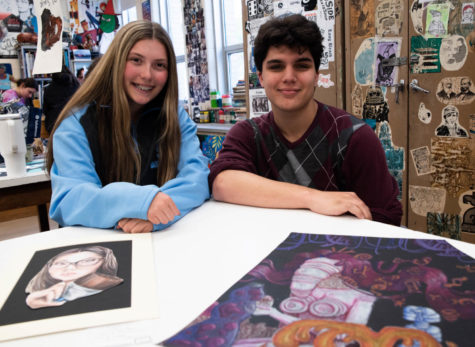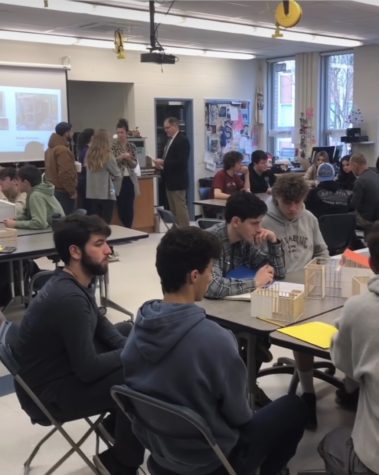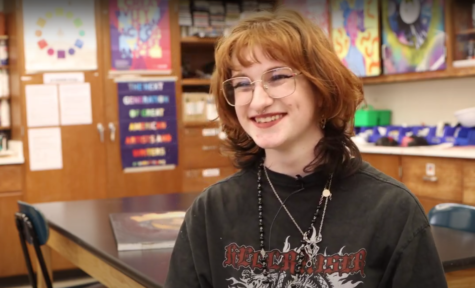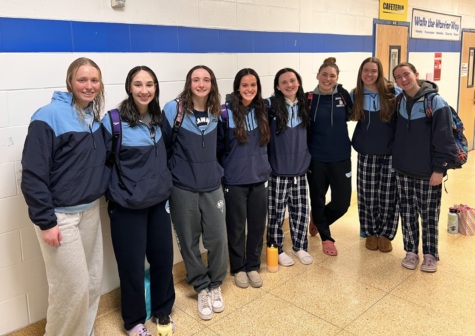School Security: If You See Something, Say Something
The front-page news of recent weeks has recounted many instances of breached school security in schools across the country. Students and parents face these accumulating tragedies or emergencies with alarm, sparking discussion within and outside of academic communities regarding how to keep educational environments safe. A comprehensive message on district home pages was posted in early February, a panel discussion was held on Wednesday, February 28, to address these concerns, and the The Renegade Report also interviewed Mr. Bookwalter, who oversees Shawnee’s security, to go into detail.
The rule of thumb is, as ever, be alert. If you see something, say something.
“The majority of school acts of violence,” says Mr Bookwalter, “occur when administrators go back and examine everything, and find that there had been some kind of warning that was not voiced or addressed.” Few events are not preceded by warning signs that could have been reported by students or other members of the community. If something is making you uncomfortable, it is your responsibility to say it to a parent, counselor, teacher, administrator, or school resource officer.
“Even if it does not turn out to be a true threat,” Mr Bookwalter explains, “you have at least given it due diligence, you’ve investigated, and we’ve made sure nothing was going to happen.” He emphasizes the importance of not disregarding social media posts that seem strange.
“Take a screenshot of it,” he urges students. “Print it out, and give it to us. Whatever you do, don’t just swipe by it thinking that’s the way he or she always is.”
If students are uneasy approaching the school themselves, they can easily have a parent, guardian, or trusted adult call the school. This has happened in the past and while it does not mean there was a legitimate threat, it was still something worth looking into. It is your decision to bring it to the forefront that can make the difference in these situations.
Students are often uncertain how to act when faced with unusual circumstances, even beyond suspicious social media posts; if they walk by a door, for example, and see somebody is outside.
“When we come in in the morning,” Mr Bookwalter says, “there are four places to enter: the main office, the cafeteria, the gym, and Door 35, out on the back towards the field hockey and volleyball lots. Once 7:20 hits we lock all of the doors — all four of those entrance points — everything is locked down.” As students well know, signs are posted around the building reminding everyone to not simply open the door and let someone in, even if it is somebody they know or recognize.
Mr Bookwalter clarifies that if, for some reason, a student left the building and wants to return, there is a procedure for that. “The only way outside during the day for students is to check in at the Main Office and then we’ll have somebody take you out–to your car or whatever–and then you come back through that same point.”
Even when teachers are outside and trying to get in, they should have a key into the building that they do not only have to use at the front door.
Of situations when teachers ask students to open the door from them, Mr Bookwalter says he can see how that would be uncomfortable, but students and teachers know the protocol. “It’s awkward, but you’re not going to get in trouble for not letting them in. You are following the rules.
“After 7:20, everyone enters through the front.”
Fortune and constant vigilance have kept Shawnee safe from large incidents, but on January 19th, 2018, students got a taste for following such predetermined procedures in an unusual situation. A power outage kept students in their classrooms while the problem was identified and fixed over more than an hour. No one was at risk, but rumors circulated over text and Snapchat, ranging from the mundane to the bizarre.
Mr Bookwalter acknowledges this. “I know there was rumors flying around then,” he says, “but as we go through these types of things, whether they are drills or if it truly is an incident, there will be information that will be emailed directly to teachers and parents.”
Students are responsible for listening to information relayed to them through those sources. It is not as instantaneous as it could be to quell all rumors, but the school must try to use communication methods that route through the server, so the best way to do that is post something on the website or directly email.
In the event that Wifi was not working, Mr Bookwalter says that anyone with a device still with cell service could check what was going on.
Of that particular power outage incident, Mr Bookwalter clarifies that they needed everyone to be in the same rooms while administration figured out what was causing the outage. “I wasn’t going to take the risk of moving everybody before we could define what was going on.” As a real incident, Mr Bookwalter says it was handled extremely well by students and staff, who remained in their classrooms until the situation was fixed and the cafeteria was ready to serve lunch.
The drills on a monthly basis, however, need work.
Students may have a tendency to separate drills from any real meaning or significance, but these events of breached security on national television should be a reminder to them that their behavior during the drills is meant to prepare them for any scenario in which they would be needed to act quickly and know what to do.
“When people hear us say the word ‘drill,’ it’s like they are going through the motions. I want the staff and students to approach these with a greater sense of urgency,” Mr Bookwalter says. “I want them to practice it like it is real, in case it ever becomes real.”
During a lockdown drill, which Mr Bookwalter defines preparation for a more serious scenario (such as an actual threat in the school or immediate area), teachers lock the door, turn out the lights, and keeping students quiet and out of sight. The primary focus of a lockdown drill is to reduce the number of rooms which appear to have students in them.
“When I go around, some rooms are not as quiet as they should be,” Mr Bookwalter says. “You want us to think the classroom is empty.” This is not happening.
Students out of class during a lockdown drill or real lockdown should find the nearest classroom and lock the door.
“If you happen to be in the bathroom, finish up and run into a classroom. What’s really going to happen in a lockdown is the police are going to come into the building. The police know all the kids are locked in the classrooms, so now whoever is in the hallway wandering around is a person of concern. It would be scary, even if was an accident. They are thinking the worst is going on. If you happen to be in the hallway, you may be seen as the problem.”
On the other hand, a shelter in place is a soft emergency, designed to maximize the efficiency of moving an ill person to an ambulance or remaining cognizant of their privacy if they have fallen or been sick. “You know how the halls are in between classes,” Mr Bookwalter says. “We don’t want five-hundred people on top of them.”
In the classroom, however, it is business as usual, and students can return back to whatever room they came from due to it not being an immediate threat. All drills, however, are arranged with the safety and security of students in mind, and should be practiced as such.
What if, in a more specific example of maintaining security, an adult in the hallways is not identifiable by a badge or otherwise?
“Tell a teacher,” Mr Bookwalter says. “Tell somebody that you do know that the person looks like a stranger. Most of our teachers you will probably know, and all substitutes have the yellow substitute IDs, but if there is a person you do not recognize, that is an issue that must be addressed.”
Typically this is a former student that is returning to visit, but as with students entering the building, there is a proper way to do this that will make them identifiable.
Adults in the building are equipped with training as to how to react in different situations. Staff go through yearly training, and then they update each time we have a drill. At a faculty meeting, Mr Bookwalter does a security piece and highlights the things that went well and the things that we need to practice. In each one of the school buildings, those in charge of security–the assistant principal, school resource officers, district personnel–go to workshops in the summer and sometimes in the school-year to learn what other schools are doing for the security of their buildings.
“I want you all to understand why we do these drills,” Mr Bookwalter says. “It is for your safety. And beyond the drills, if you see something, say something. If you see something that is not right or somebody you don’t know, let somebody know.”






